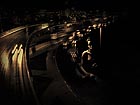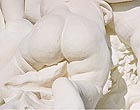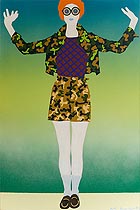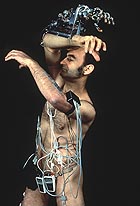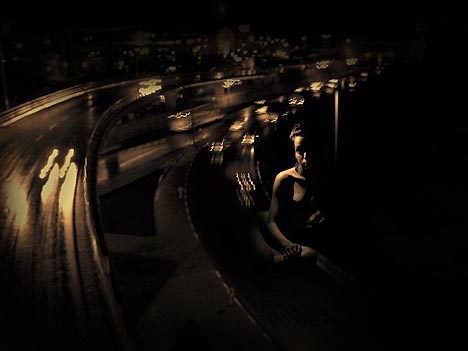
translated and summarized by: Liz Wollner-Grandville,
English summaries November 22 - December 5
Austellungszentrum Heiligenkreuzerhof
Iran – preview of the past
10.11.10 to 10.12. 10
Identity and subversion
Three women came together to jointly realize each of their individual project dreams. In “IRAN preview of the past” the artist Sini Coreth, the art historian Julia Allerstorfer and Barbara Putz-Plecko, professor at the University for Applied Arts, offer a remarkable insight into Iranian contemporary art – a representative cross-section from a personal point of view.
Many of the forty photo- and video works were created in Vienna; others were imported from Teheran with the help of digital data media. The selection of works of the 18 Iranian artists, were created between 2004 and 2010 and focused on the era prior to the questionable elections in 2009.
In “Preview of the past” the individual artistic positions are placed in diverse retrospectives and visions, from the viewpoint of the past as well as that of the current situation. Even if the curators definitely did not aim at organizing a political exhibition, the presence of the repressive Iranian regime in the life and work of the artists cannot be denied.
Immediately upon entering the exhibition the visitor is confronted with the obligatory self-censorship artists are faced with in Iran. The censorship, which even affects depictions of Titian’s Allegories or the Gothic Madonna lactans, whose nudity was cached with the lines of a black felt pen, is transferred into modern fashion photography by Shadi Ghadirian in “West by East” or “Real Ones”: simultaneously representing criticism of political control and art.
The extensive relevance and explosive nature of female-identity and integrity, existent in principle in broad-minded Iranian cultural circles, is evident in practically every exhibited piece. Controversies and paradoxes become obvious in their blatant polarity. In “Harem Project”, Afshan Ketabchi positions voluptuous female protagonists into the traditional art form of Persian book painting. In Ramin Haerizadeh’s “Bad Hejab” (the artist was expelled to Dubai), photomontages demonstrate and unmask the gender role-play in everyday life.
The works are coined by the question of identity: at times they focus on the young generation per se, (Neda Hoisseinyar), and in another instance they concentrate on the definition of their own individual personality (Saleh Rozati). With reference to the violent conflict with Iraq the already multifaceted problem is even more accentuated. The implicit and resulting discrepancies, insecurities, psychic breaches and anxieties find their dismal manifestation in films: poetic and rich in metaphors as in Behrang Samadzadegan’s “Open Seas” or melodramatic in Mehdi Sadr’s “Replica”.
This content-related ambiguity and subversity, which was necessary for artists to survive in the Iranian political system, characterize works that were created outside of the country, in Vienna. Memories and visions are superimposed and intertwined, transformed to an extract and made concrete as essential issues.
By Margareta Sandhofer
Austellungszentrum Heilingenkreuzerhof
1010 Vienna, Schönlaterngasse 5
Tel: +43 1 711 33 6300
Fax: +43 1 711 33 6309
email: veranstaltungsreferat@uni-ak.ac.at
dieangewandte.at
Opening hours: Tue to Fri 11 a.m. – 6 p.m., Sat 10 a.m. – 5 p.m. (closed on holidays)
Startgalerie im Museum auf Abruf
Timotheus Tomicek, Ulrich Eigner – It’s there
17.11.2010 – until 11.12.2010
Observe - and play
Within the framework of the European Month of Photography at the Startgalerie in the MUSA, two young photographers offer insight into their work: Ulrich Eigner works in the classic field and follows the long tradition of documentary photographers. He displays a series of works depicting the seeming idyll in the Austrian Alps - with no comment and a slightly ironic bias: a barn and the shape of its pitched roof that is mirrored in the shape of the mountain range behind it, making it unclear what was man-made and what was nature. In his works, Eigner, born 1973, masterfully plays with shapes without letting his work appear artificial.
The works by Timotheus Tomicek on the other hand are absolutely construed, and that’s exactly what makes them fascinating. He dominates the exhibition with his playful, almost baroque works as well as a small, unexpected installation. The MUSA-exhibition benefits from the fact that the works by the artists are spatially divided. Tomicek’s photographs stand out in the Rocaille-decorated gold frames in digital monitors. One of these pictures shows an extravagantly clad young woman kneeling in front of a small table and placing a domino on top of domino-tower. After a few seconds one is amazed to realize that the photo moves; it is a kind of “minimalistic animation”. The woman in the picture titled “one more” undertakes a minimal movement showing that she doesn’t actually place the last domino onto the pile. This surprise effect is a Leitmotiv for the pieces displayed at the exhibition – such as a miniature dragon - at first only recognizable by its shadow - flies around the gallery room, incessantly following its own tracks.
By Wolfgang Pichler
Stargalerie im Museum auf Abruf
1010 Vienna, Felderstrasse 6-8 (next to the town hall)
Tel: +43 1 4000 8400
email: artothek@musa.at
www.musa.at
Opening hours: Tue, Wed, Fri: 11 a.m – 6 p.m, Thu: 11 a.m. – 8 p.m., Sat: 11 a.m. – 4 p.m.
Kunsthalle Wien
Power up - Female Pop Art
05.11.10 to 20.02.11
Out of the Woodwork
This piece of information has little news value: female artists have always been neglected by the art industry. Linda Nochlin established this fact already in 1971. When her epochal text "Why have there been no great women artists" appeared, one could have hoped for betterment in terms of the fact that now, female gallery owners, curators and critics had been made aware of the all-encompassing exclusion mechanism. But apparently for some unknown reason this never happened.
Otherwise how can one explain that the majority of female artists in the exhibition "Power Up. Female Pop Art" (curator: Angela Stief) in the Kunsthalle Wien, are almost unknown? For instance, Jann Haworth: her soft sculptures which she invented before - or at least at the same time as - Claes Oldenburg, have up until now been withheld from the wider public. Or Christa Dichgans: one is strongly reminded of Jeff Koons' later plastics and paintings when confronted with her gaudily painted inflatable hearts or curious, uncanny looking toys. The extremely fresh-looking plastics of a Marisol have, to date, been at best a theme at female art history seminars, and, similarly, the fomenting placards by Sister Corita Kent or the Happenings of Evelyne Axell have almost disappeared into the woodwork.
Partially, the works of more popular female artists are also cause for surprise: Who knew, for instance, that apart from her heads which are suitable for the art markets, Kiki Kogelnik's oeuvres contain some really gruesome aspects? Her obsessive-erotic drawings in which genitalia are attacked and investigated in a voyeuristic manner are no less stupendous than the kitschy golden altar by Niki de Saint Phalle.
The question only remains as to whether or not the female artists represented here can really be seen as belonging to Pop Art. However, in light of the permeability of this trend, as with every other, it should not be viewed too closely. And that the configuration of the show - with portraits on advertising pillars and objects in shop windows - takes Pop Art into account, although the exhibits themselves are not in the limelight, its meaning is by no means impaired.
By Nina Schedlmayer
Kunsthalle Wien,?1070 Vienna, Museumsplatz 1
Tel: +43 1 521 89-0
Fax: +43 1 521 89-0
www.kunsthallewien.at
Opening hours: daily 10 a.m. – 7 p.m.
Kunsthaus Graz
Robot dreams
09.10.10 to 20.02.11
Myths – Men – Machines
The introduction of technology into the human existence was and is - from an historic point of view - one of steady progression. Likewise that of the dream of the perfect human being. The speed of both developments began to accelerate rapidly in the 18th century. And in these developments, it always centered around man himself even if it often appeared that the focus was laid on technology. The exhibition in the Kunsthaus Graz - in co-operation with the Museum Tinguely, Basel - which calls itself Robot Dreams and interestingly enough, plays on the double meaning of the dreams about robots and the dream of robots.
The starting point is Isaac Asimov’s short story with the same title, in which a robot is eliminated, who begins to dream and further, who imagines himself as a human being, all of which is not allowed since it conflicts in every case with the robot laws created by Asimov. This is also an element which appears in the science fiction film, "I, Robot" one of the films which Virgil Widrich uses for his film collage "make / real" (2010). Here, Widrich creates a work of incredible intensity in which he compresses key scenes from science fiction films together, thereby not presenting the robot itself but rather a whole view of the picture, the robot's dream.
The spectrum of the exhibition encompasses contemporary works, which sound out the present technical possibilities such as, for example, those of Jessica Field, Sibylle Hauert and Daniel Reichmuth or John Dekron, or declare technology and culture as areas of tension.
Kirsty Boyle's work, "Tree Ceremony" (2010) a robot figure, clothed as a geisha girl, is engaged in a Shinto ritual with a tree. From time to time, the robot shows his true technical framework. But works, which have acquired an art history status, are also exhibited such as Walter Pichler's "TV helmet (portable living room)" (1967), Nam June Paik's "Andy Warhol Robot" (1994), or Richard Kriesche's work "A World Model" (1986). All in all, a spectrum of works is exhibited that encompasses a theme range, which, in spite of every technology, always has man as the centre point.
By Nora Theiss
Kunsthaus Graz?8020 Graz, Lendkai 1
Tel: +43/316/8017-9200
Fax: +43/316/8017-9800
E-mail: info@kunsthausgraz.at
www.kunsthausgraz.at
Opening hours: Tue-Sun: 10.00 a.m. -6 p.m. Thu: 10.00 a.m. – 8 p.m.
Mehr Texte von translated and summarized by: Liz Wollner-Grandville


 Teilen
Teilen

